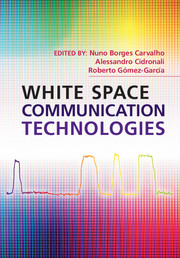Preface
Published online by Cambridge University Press: 05 October 2014
Summary
White space technologies is an area of great interest in the technology, information, and communication field, due mainly to the possibility to have cooperating radios that will optimize the transmission parameters to achieve the best possible performance. This area achieved even greater importance due to the possibility to use frequency bands that are under-utilized, or are used sparsely – one of the cases being the TV band that was empty after the analog-to-digital TV switch over.
White space radios should be agile and adapt to the radio interface with a clear view and optimized operation; that is why special care should be taken with these types of radio and a special design procedure should be followed and discussed. It is exactly in this area that this book fits, by discussing technological implementation details and processes that are fundamental for building cognitive radios that will be the basis of white space devices.
The book is divided into three parts, each one with three chapters. The first part is focused on the general problems we face in white space technology and signal processing. The second part will focus on adaptable receivers for white space devices, and the final part will be focused on adaptable transceivers.
The first chapter of the book “White space technology, the background” will start the discussion of these radios and give some technological views.
- Type
- Chapter
- Information
- White Space Communication Technologies , pp. xiii - xviPublisher: Cambridge University PressPrint publication year: 2014



